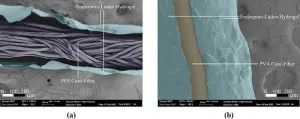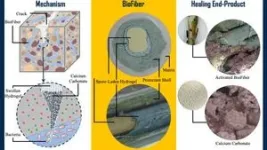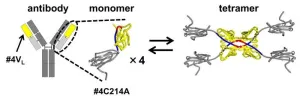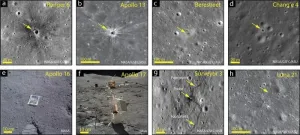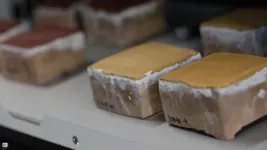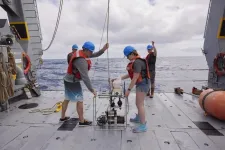(Press-News.org) In hopes of producing concrete structures that can repair their cracks, researchers from Drexel University’s College of Engineering are putting a new twist on an old trick for improving the durability of concrete. Fiber reinforcement has been around since the first masons were mixing horsehair into their mud. But the Drexel research team is taking this method to the next level by turning reinforcing fibers into a living tissue system that rushes concrete-healing bacteria to the site of cracks to repair the damage.
Recently reported in the journal Construction and Building Materials, Drexel’s “BioFiber” is a polymer fiber encased in a bacteria-laden hydrogel and a protective, damage-responsive shell. The team reports that a grid of BioFibers embedded within a concrete structure can improve its durability, prevent cracks from growing and enable self-healing.
“This is an exciting development for the ongoing efforts to improve building materials using inspiration from nature,” said Amir Farnam, PhD, an associate professor in the College of Engineering who was a leader of the research team. “We are seeing every day that our ageing concrete structures are experiencing damage which lowers their functional life and requires critical repairs that are costly. Imagine, they can heal themselves? In our skin, our tissue does it naturally through multilayer fibrous structure infused with our self-healing fluid — blood. These biofibers mimic this concept and use stone-making bacteria to create damage-responsive living self-healing concrete.”
Lengthening the lifespan of concrete is not just a benefit for the building sector, it’s become a priority for countries around the world that are working to reduce greenhouse gas. The process of making the ingredients of concrete — burning a mixture of minerals, such as limestone, clay or shale at temperatures in excess of 2,000 degrees Fahrenheit — accounts for 8% of global greenhouse gas emissions.
Concrete structures can degrade in as little as 50 years depending on their environment. Between replacements and the growing demand for new buildings, concrete is the most consumed and most in-demand building material in the world.
Producing concrete that can last longer would be a big step in reducing its contribution to global warming, not to mention reducing the long-term cost of infrastructure repairs, which is why the U.S. Department of Energy has recently launched efforts focused on improving it.
Over the last decade, Drexel has led the way in looking at how to improve concrete’s sustainability and durability, and Farnam’s lab is part of a team participating in a Department of Defense effort to fortify its aging structures.
“For several years, the concept of bio-self-healing cementitious composites has been nurtured within the Advanced Infrastructure Materials Lab,” said Mohammad Houshmand, a doctoral candidate in Farnam’s lab who was the lead author of the research. “The BioFiber project represents a collaborative, multidisciplinary endeavor, integrating expertise from the fields of civil engineering, biology, chemistry, and materials science. The primary objective is to pioneer the development of a multifunctional self-healing BioFiber technology, setting new standards at the intersection of these diverse disciplines.”
The team’s approach in creating BioFibers was inspired by skin tissue’s self-healing capability and vasculature system’s role in helping organisms heal their own wounds. And it uses a biological technique they developed to enable self-repairing in concrete infrastructure with the help of biomineralizing bacteria.
In collaboration with research teams led by Caroline Schauer, PhD, the Margaret C. Burns Chair in Engineering, Christopher Sales, PhD, an associate professor, and Ahmad Najafi, PhD, an assistant professor, all from the College of Engineering, the group identified a strain of Lysinibacillus sphaericus bacteria as a bio-healing agent for the fiber. The durable bacteria, typically found in the soil, has the ability to drive a biological process called microbial induced calcium carbonate precipitation to create a stone-like material that can stabilize and harden into a patch for exposed cracks in concrete.
When induced into forming an endospore the bacteria can survive the harsh conditions inside concrete, lying dormant until called into action.
“One of the amazing things about this research is how everyone comes at the problem from their different expertise and the solutions to creating novel BioFibers are so much stronger because of that,” Schauer said. “Selecting the right combination of bacteria, hydrogel and polymer coating was central to this research and to the functionality of BioFiber. Drawing inspiration from nature is one thing, but translating that into an application comprised of biological ingredients that can all coexist in a functional structure is quite an undertaking — one that required a multifaced team of experts to successfully achieve.”
To assemble the BioFiber, the team started with a polymer fiber core capable of stabilizing and supporting concrete structures. It coated the fiber with a layer of endospore-laden hydrogel and encased the entire assembly with a damage-responsive polymer shell, like skin tissues. The entire assembly is a little over half a millimeter thick.
Placed in a grid throughout the concrete as it is poured, the BioFiber acts as a reinforcing support agent. But its true talents are revealed only when a crack penetrates the concrete enough to pierce the fiber’s outer polymer shell.
As water makes its way into the crack, eventually reaching the BioFiber, it causes the hydrogel to expand and push its way out of the shell and up toward the surface of the crack. While this is happening, the bacteria are activated from their endospore form in the presence of carbon and a nutrient source in the concrete. Reacting with the calcium in the concrete, the bacteria produce calcium carbonate which acts as a cementing material to fill the crack all the way to the surface.
The healing time ultimately depends on the size of the crack and activity of the bacteria — a mechanism the team is currently studying — but early indications suggest the bacteria could do its job in as little as one to two days.
“While there is much work to be done in examining the kinetics of self-repair, our findings suggest that this is a viable method for arresting formation, stabilizing and repairing cracks without external intervention,” Farnam said. “This means that BioFiber could one day be used to make a ‘living’ concrete infrastructure and extend its life, preventing the need for costly repairs or replacements.”
END
Veins of bacteria could form a self-healing system for concrete infrastructure
Drexel University's ‘BioFiber’ can stabilize and heal damaged concrete
2023-12-08
ELSE PRESS RELEASES FROM THIS DATE:
First observation of structures resulting from 3D domain swapping in antibody light chains
2023-12-08
Ikoma, Japan – Antibodies (immunoglobulins) are Y-shaped proteins that recognize and neutralize specific pathogens. Their ability to target specific molecules or cells has made them promising candidates for future drug development. However, their light chains—parts of the antibody that contribute to recognizing and binding to specific antigens—misfold and aggregate, leading to amyloidosis, a condition that brings about complications and tissue dysfunction in the body. In the context of drug development, antibody aggregation can compromise their capacity to bind to antigens ...
Scholars say it's time to declare a new epoch on the moon, the 'lunar Anthropocene'
2023-12-08
LAWRENCE — Human beings first disturbed moon dust on Sept. 13, 1959, when the USSR’s unmanned spacecraft Luna 2 alighted on the lunar surface. In the following decades, more than a hundred other spacecraft have touched the moon — both crewed and uncrewed, sometimes landing and sometimes crashing. The most famous of these were NASA’s Apollo Lunar Modules, which transported humans to the moon’s surface to the astonishment of humankind.
In the coming years, missions and projects already planned will change the face of the moon ...
Researchers safely integrate fragile 2D materials into devices
2023-12-08
Two-dimensional materials, which are only a few atoms thick, can exhibit some incredible properties, such as the ability to carry electric charge extremely efficiently, which could boost the performance of next-generation electronic devices.
But integrating 2D materials into devices and systems like computer chips is notoriously difficult. These ultrathin structures can be damaged by conventional fabrication techniques, which often rely on the use of chemicals, high temperatures, or destructive processes like etching.
To overcome this challenge, researchers from MIT and elsewhere have developed a new technique to integrate 2D materials into devices in a single ...
Digital multi-sided platforms transform traditional value chains in business-to-business service sales
2023-12-08
Various digital platforms are becoming increasingly common in business-to-business (B2B) activities. They enable building competitiveness and boosting selling and buying. The platforms also offer different ways of building long-term customer relationships in B2B service sales. A recent study found that digital platforms are transforming traditional value chains based on linear value creation towards a platform-based, multi-sided, digital value network.
“The network is administered and orchestrated by the platform owner, who must attract a sufficient number ...
The first European manifesto for more sustainable museums
2023-12-08
Venice, Amsterdam, Paris, December 8, 2023 – Today, the Center for Cultural Heritage Technologies of the Italian Institute of Technology (CCHT-IIT), the University of Amsterdam/Rijksmuseum, and CNRS/École Normale Supérieure de Paris-Saclay launch the first manifesto for sustainable conservation of cultural heritage. The manifesto aims to improve conservation practices and promote more sustainable and ecological methods in museum practices.
During the COP28 in Dubai, the United Nations event on ...
Atlantic Ocean near Bermuda is warmer and more acidic than ever, 40 years of observation show
2023-12-08
Decade-long ocean warming which impacts ocean circulation, a decrease in oxygen levels that contributes to changes in salinification and nutrient supply, and ocean acidification are just some of the challenges the world’s oceans are facing.
In 1988, a comprehensive sustained ocean time-series of observations, called the Bermuda Atlantic Time-series Study (BATS), began at a site about 80 km southeast of the island of Bermuda. There, scientists take monthly samples of the physics, biology, and chemistry of the ocean’s surface and depths. In a new paper published in Frontiers in Marine Science, researchers have now presented the latest findings from ...
Battle of the AIs in medical research: ChatGPT vs Elicit
2023-12-08
Can AI save us from the arduous and time-consuming task of academic research collection? An international team of researchers investigated the credibility and efficiency of generative AI as an information-gathering tool in the medical field.
The research team, led by Professor Masaru Enomoto of the Graduate School of Medicine at Osaka Metropolitan University, fed identical clinical questions and literature selection criteria to two generative AIs; ChatGPT and Elicit. The results showed that while ChatGPT suggested fictitious articles, Elicit was efficient, suggesting multiple references within a few minutes with the same level of accuracy as the researchers.
“This ...
Aston University research finds peer support vital for those taking medication for severe mental illness
2023-12-08
Research has found many challenges to medication adherence in people living with severe mental illness
Talking to those with similar conditions on similar medication may offer more reassurance and useful advice
The researchers worked with people with severe mental illness to better understand their lived experience.
Researchers at Aston Pharmacy School have found that people with severe mental illness could benefit from peer support to help them manage their medication and improve their health and quality of life.
The study, which was set up to review the complexities ...
Even small amounts of physical activity could be valuable in late-stage lung cancer
2023-12-08
Lung cancer kills more people globally each year than any other type of cancer, however new Curtin University-led research has found less than five minutes of daily physical activity could be linked with prolonged life in people living with inoperable forms of the disease.
The team from Curtin School of Allied Health, Curtin enAble Institute and other research organisations measured the daily activity of 89 people living with inoperable lung cancer, from the time of their diagnosis.
They then compared the mortality rates after 12 months between those who engaged in more moderate-to-vigorous ...
Telehealth mindfulness-oriented recovery enhancement vs usual care in individuals with opioid use disorder and pain
2023-12-08
About The Study: In this randomized clinical trial of 154 individuals with chronic pain in methadone treatment for an opioid use disorder, relative to usual care, Mindfulness-Oriented Recovery Enhancement (MORE) plus usual care demonstrated efficacy for decreasing drug use, pain, and depression and increasing methadone treatment retention and adherence. Participants receiving MORE attended eight weekly, 2-hour telehealth groups that provided training in mindfulness, reappraisal, and savoring in addition to usual care.
Authors: Nina Cooperman, Psy.D., of ...
LAST 30 PRESS RELEASES:
Trauma or toxic? A deep dive into the impact of stress on kids' health
Turning industrial exhaust into useful materials with a new electrode
ORNL to partner with Type One Energy, UT on world-class facility to validate next-gen fusion
New journal section tackles AI, ethics, and digital health communication
Jeonbuk National University researchers develop novel dual-chemical looping method for efficient ammonia synthesis
New study sheds light on stroke recovery via exercise-induced migration of mitochondria
SEOULTECH researchers develop sodium-based next-generation smart electrochromic windows
Data-driven analysis reveals three archetypes of armed conflicts
Heart disease, stroke deaths down, yet still kill more in US than any other cause
Light switches made of ultra-thin semiconductor layers
Creative talent: has AI knocked humans out?
Sculpting complex, 3D nanostructures with a focused ion beam
A year after undermining Bredt’s rule, UCLA scientists have made cage-shaped, double-bonded molecules that defy expectations
Human activities drive global dryland greening
PeroCycle announces new appointments as it builds a world-class board for meaningful climate impact
Magnetic avalanches power solar flares
LeapSpace goes live: the Research-Grade AI-Assisted Workspace built on trusted science
DNA tests reveal mysterious beluga family trees
Strategic sex: Alaska’s beluga whales swap mates for long-term survival
How early cell membranes may have shaped the origins of life
Cannabis legalization is driving increases in marijuana use among U.S. adults with historically lower consumption rates
Multifunctional dipoles enabling enhanced ionic and electronic transport for high‑energy batteries
Triboelectric nanogenerators for future space missions
Advancing energy development with MBene: Chemical mechanism, AI, and applications in energy storage and harvesting
Heteroatom‑coordinated Fe–N4 catalysts for enhanced oxygen reduction in alkaline seawater zinc‑air batteries
Meta-device for precision lateral displacement sensing
Plasma-guided mitotane for the treatment of adrenocortical carcinoma: adjuvant care to advanced disease
Theoretical study of laser-enhanced nuclear fusion reactions
Social environment impacts sleep quality
Optimized kinetic pathways of active hydrogen generation at Cu2O/Cu heterojunction interfaces to enhance nitrate electroreduction to ammonia
[Press-News.org] Veins of bacteria could form a self-healing system for concrete infrastructureDrexel University's ‘BioFiber’ can stabilize and heal damaged concrete
